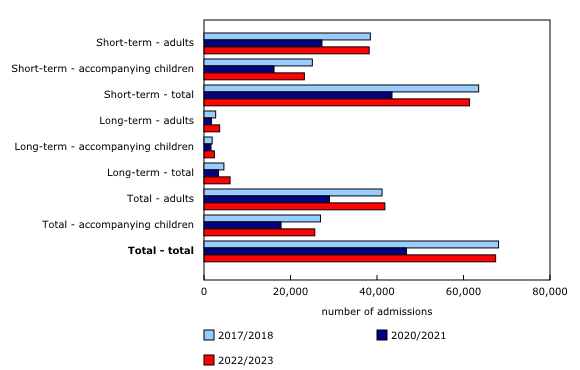Canadian residential facilities for victims of abuse, 2022/2023
Released: 2024-04-10
Number of women admitted to residential facilities returns to pre-COVID-19 pandemic admission numbers
In 2022/2023, there were 67,430 admissions to the 562 residential facilities in Canada whose primary mandate is to serve victims of abuse. Women (61%) made up the majority of admissions, followed by children accompanying an adult (38%). The number of admissions in 2022/2023 was 44% higher compared with admissions in 2020/2021, during the pandemic; however, they were similar to the number of admissions reported in 2017/2018.
Results from the 2022/2023 Survey of Residential Facilities for Victims of Abuse are being released today in the Juristat article "Canadian residential facilities for victims of abuse, 2022/2023." Results presented refer to two distinct time periods: a 12-month period in 2022/2023 and a snapshot date of April 13, 2023. Taken together, results provide an overview of facility characteristics, touching on shelter admissions, availability of accommodations, and general services provided, as well as a profile of residents using residential facilities on the snapshot date.
Women and accompanying children make up vast majority of residents on snapshot date
On the survey snapshot date of April 13, 2023, there were 7,686 individuals staying in residential facilities for victims of abuse. Just over half (53%) of these residents were women and 45% were accompanying children. This pattern was consistent in both short- and long-term shelters and in shelters in urban and rural areas.
Just over three-quarters of women residents experienced abuse by a current or former intimate partner
About two-thirds (65%) of women residents in shelters on the snapshot date experienced emotional or psychological abuse. Experiences of physical abuse (58%) and financial abuse (39%) were also commonly experienced by women residents in shelters. A current or former intimate partner was the abuser for just over three-quarters (76%) of women residing in shelters on the snapshot date.
Indigenous women and children overrepresented as shelter residents
Although Indigenous (First Nations, Métis and Inuit) women comprise 5% of the total population of women in Canada, 30% of women residing in shelters for reasons of abuse on the snapshot date were of Indigenous identity. Indigenous children were also overrepresented as residents of shelters for victims of abuse. Despite accounting for 8% of children in the Canadian population, Indigenous children comprised 24% of all accompanying children in facilities.
Just over three-quarters of funded beds in short-term facilities occupied on snapshot date
Just over three-quarters (77%) of the 7,375 funded beds in short-term facilities across Canada were occupied on the snapshot date. Overall, 33% of short-term facilities were considered full, that is, at or over capacity. Approximately 31% of facilities reported turning away women on the snapshot date. Facilities that turned away women indicated that the majority of women (83%) were turned away because the shelter was full.
Did you know we have a mobile app?
Get timely access to data right at your fingertips by downloading the StatsCAN app, available for free on the App Store and on Google Play.
Note to readers
This Juristat article uses data from the Survey of Residential Facilities for Victims of Abuse (SRFVA). The SRFVA collected annual (2022/2023 fiscal year) and snapshot day (April 13, 2023) information on residential facilities in Canada that are primarily mandated to serve victims of abuse.
Facilities were asked to report the type of facility they operated based on the expected length of stay provided for in their service mandate, regardless of practice. They were grouped into two categories:
Short-term residential facilities include those with a general policy of providing accommodation for less than three months and typically provide individual beds to residents.
Long-term residential facilities include those with a general policy of providing accommodation for three months or more and typically provide residential units (for example, apartments or houses) to residents.
The SRFVA is a redesign of the Transition Home Survey (THS), which was conducted every two years from 1993 through 2014. Due to differences in survey scope and content, data collected for the SRFVA are not comparable with historical THS data.
An urban area is defined as a census metropolitan area (CMA) or a census agglomeration (CA). Rural areas are all areas outside of CMAs and CAs.
Population data for Indigenous and non-permanent resident populations in Canada are based on 2021 Census of Population estimates from the long-form census questionnaire. Readers should be aware that the universe for the long-form census questionnaire is the population in private households only, which excludes persons in collective dwellings. Additionally, while every attempt has been made to enumerate non-permanent residents, there are factors (for example, not being aware of the need to participate) which may have affected the estimate of this population. Previous coverage studies have indicated that the non-permanent resident population was missed at a higher proportion than the general population.
Products
The article "Canadian residential facilities for victims of abuse, 2022/2023" is now available as part of the publication Juristat (85-002-X).
Additional data are available upon request.
Contact information
For more information, or to enquire about the concepts, methods or data quality of this release, contact us (toll-free 1-800-263-1136; 514-283-8300; infostats@statcan.gc.ca) or Media Relations (statcan.mediahotline-ligneinfomedias.statcan@statcan.gc.ca).
- Date modified:

